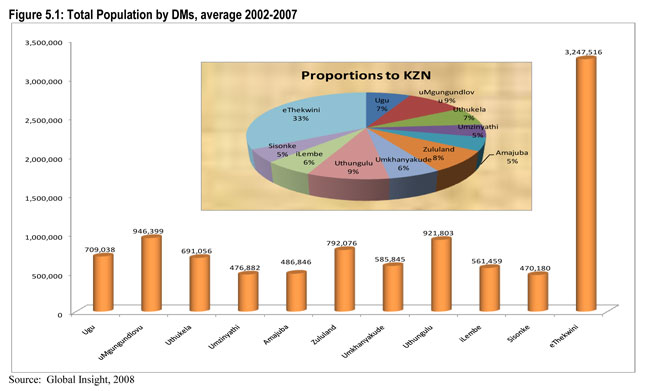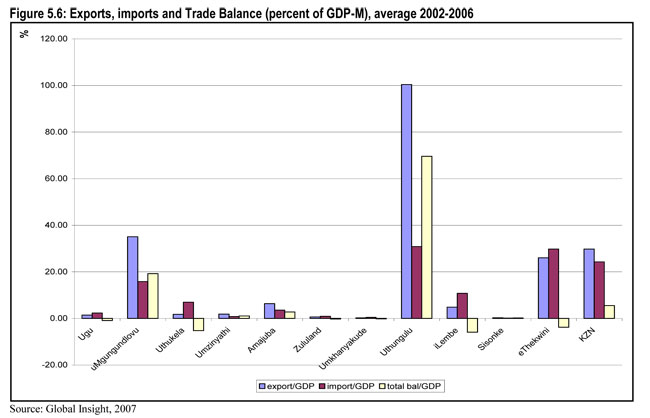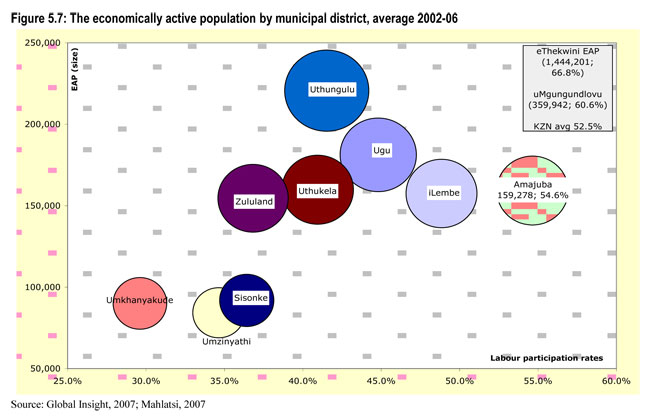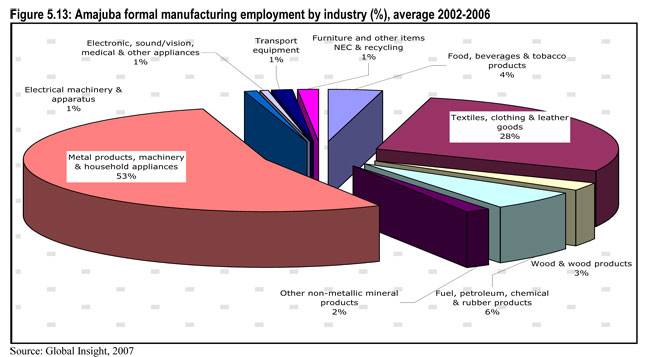KZN Districts
- Amajuba
Overview

The Amajuba district municipality covers three municipalities: Newcastle, Danhauser and Utrecht. The economy is concentrated in Newcastle-Madadeni-Osizweni and Umnambithi/Ladysmith axis. The economic activities of this area are very skewed as the majority of people live in rural areas and rely heavily on government social services. Economically this district is the fifth largest contributor to the provincial GGP, standing at 3%. Statistically there are 468 037 people living in this district of which 72 332 are employed with a total labour force of 284 595.
Sectors

Manufacturing Sector
Manufacturing sector is the largest contributor to the district economy. Amajuba manufacturing sector involves automotive, chemicals and plastics, pharmaceuticals, clothing and textiles, food and beverages, leather and footwear.
Tourism Sector
Tourism sector is one of the key potentials for economic development in the district. The district has natural and historical attraction such as battlefields, cultural events, and fishing, bird watching and game reserves.
Agricultural Sector
The agricultural activities in the district are crop farming (i.e. Soya, maize, wheat, dried tomatoes and varied
vegetables and seedling production), diary production, aquaculture, poultry and livestock.
For further information
on generic sectors in the whole of KwaZulu-Natal, kindly click here.
Investment Opportunities
Amajuba District Municipality is situated within the north western corner of the KwaZulu-Natal. The district has abundant water, a reliable labour force, well developed transport infrastructure, first world educational, medical and community services, internationally-acclaimed tourism attractions, and an enviable lifestyle. It comprises of three local municipalities namely Newcastle, Dannhauser and Utrecht. The district’s economy was historically focused on coal mining but colliers have closed. The municipality is predominately urban and the largest concentration of people occurs in the Newcastle, Madadeni, Osizweni areas.
Below are packaged projects throughout Amajuba District with concise project descriptions, information on locations, current statuses, ownership, return on investment and importantly project requirements.
Development Corridors
Spatial Development Corridor
Nodes and Development Corridors for KZN for the next five years.
| The eThekwini / uMhlatuze Corridor, focusing primarily on development opportunities being presented as part of the La Mercy/DTP Development and creating opportunities for linking and strengthening the second and first economy. |
| eThekwini/Msunduzi / uMngeni Corridor, focusing primarily on establishing inter-municipal planning processes to ensure that the development opportunities presented in this region are optimised. |
| Umhlatuze/Ulundi/Vryheid (P 700) Corridor as a new link between the Richards Bay harbor and Gauteng, focusing primarily on the section between Ulundi and the Cengeni Gate of Umfolozi Game Reserve, and the Ulundi Airport. |
| Lebombo SDI Corridor, focusing primarily on Developments along the southern and eastern sections of the Pongola Poort Dam, tourism facilities along the new SDI Route to Mozambique, large scale agricultural development and enhancing the development opportunities related to the Greater St Lucia Wetland Park. |
| Port Shepstone/St Faiths/Ixopo Corridor, focusing primarily on Developing a direct link between the Southern Drakensberg and the Coastal areas to expand the basket of tourist destinations and spending options. |
| Battlefields Route Corridor (Umzinyathi), focusing primarily on the route between Dundee and Greytown via Msinga, as a priority for the further development of the battlefields routes of the Province. |

Departmental Nodes - Amajuba
DC25: Agriculture and Land Reform
| Livestock farming - develop livestock farming opportunities in Trust land |
| Support land reform beneficiaries - livestock, game farming & explore others |
| Develop Chelmsford Dam agricultural complex (serviced by Vryheid node) |
DC25: Tourism
-Battle fields routes: development of linkages to benefit previously disadvantaged
Drakensberg eco-tourism: develop cultural tourism opportunities with bordering communities
DC25: Industry
| Newcastle Industrial townships: provision of world class infrastructure, improve linkages to ports |
| Provide adequate affordable housing and related services |
| Bio-diesel production |
| Coal mining - extension of life of mines and/or development of alternative opportunities |
DC25: Services
Agrarian Revolution Target Areas (2006/7)
Finally, the Agrarian Revolution Strategy has clearly identified targeted Districts for 2006/7 which should each receive approximately R35m of Siyavuna funding . Each district will have specific targeted commodity focus areas that respond to the Provincial Agricultural Framework, areas of identified Hunger, and the priority areas identified by the Provincial Government and the Premier for 2006/7 specifically.
Existing Investors
| COMPANY NAME | SOURCE COUNTRY | WEBSITE |
|---|---|---|
| Andina Group South African Calcium Carbide – [SACC] | Spain | www.andinagroup.com |
| Arcelor Mittal | Luxembourg | www.arcelormittal.com |
| Siemens | Germany | www.siemens.co.za |
Amajuba District Municipality
Amajuba District Municipality is situated within the north western corner of the KwaZulu-Natal. The district has abundant water, a reliable labour force, well developed transport infrastructure, first world educational, medical and community services, internationally-acclaimed tourism attractions, and an enviable lifestyle. It comprises of three local municipalities namely Newcastle, Dannhauser and Utrecht. The district’s economy was historically focused on coal mining but colliers have closed. The municipality is predominately urban and the largest concentration of people occurs in the Newcastle, Madadeni, Osizweni areas.
Amajuba District: Socio-Economic Profile
- Demographics
- The KwaZulu-Natal Province has both growing and maturing population, presenting opportunities and challenges to the province. According to Statistics South Africa mid-year estimates (2008), the KwaZulu Natal population was estimated at an average size of 10,1 million people. The largest number of these people lived in eThekwini Metro (32.8 percent of the provincial population), followed by uMgungundlovu (9.5%) and uThungulu district (9.3%).
- Amajuba district had an estimated total population of 486,8 thousand, accounting for 5.0 percent of the provincial population between 2002 and 2007 (Figure 5.1).
- Figure 5.2 shows the distribution of the population across DMs by age group. The largest proportion of the
population in Amajuba district was the age group 15-64 years (61.0%) followed by age group 0-14 years (35,1%).
The elderly population made the smallest portion of the total population.
More potential work seekers translate into higher unemployment levels, particularly if individuals are not appropriately skilled. Hence, the higher number of both young individuals and people in the labour force overall will require more spending in education (primary and secondary) and skills development. The majority of the population across all DMs was female during this period (Figure 5.3). - Economic Outlook
- Between 2002 and 2006, the GDPR for KwaZulu-Natal was estimated at an annual average of R177, 8bn. There was significant growth of 18.8 percent from R163,9bn in 2002 to R194,7bn in 2006. Amajuba was the fifth largest contributor to the province’s GDP-R at 3.6 percent, after eThekwini (64.6%), uThungulu (9.5%), uMgungundlovu (8.5%), and Ugu (3.7%).
- Figure 5.5 shows Amajuba’s GDP-M by economic sector between 2002 and 2006. During this period the economy of the district grew by an annual average of 3.9 percent. Manufacturing, Community Services, and Finance were the main economic drivers in the district. These sectors contributed respective annual averages of 35.1 percent, 21.8 percent, and 14.0 percent to the district’s GDP-M.
- International Trade
- Figure 5.6 shows the percentage of exports, imports and trade balance (as a proportion of the districts’ GDP-M), between 2002 and 2006. The figure reveals that international trade has minimal impact on the economy of Amajuba. The district’s imports made up 2.3 percent of the district’s GDP-M and its exports were a mere 1.4 percent on average over the 5 year period. This resulted in a negative trade balance of R59,692 (or 0.9%).
- The Labour Market
- Between 2002 and 2006, when the provincial labour force 1 approximated 6,0 million people per annum (approximately 60.0 percent of total provincial population), the economically active population (EAP)2 was approximately 3,1 million. More than 1,4 million of the province’s EAP was found in eThekwini, followed by UMgungundlovu (360,000) and uThungulu (221,000). Amajuba’s EAP size, estimated at 160,000, fell in the same range as Zululand, Uthukela and iLembe (Figure 5.7).
- 1 Labour force is population aged 15-64 years.
2 The category EAP is made up of people who are either employed or unemployed. The employed consists of employers and employees, while unemployment are those not having a job but are actively seeking one (official definition), or they do not have a job, are actively seeking one or have given up searching yet still available for work at anytime (expanded definition).
As a proportion of the district labour force3, however, the district’s EAP was estimated at 54.6 percent. At this rate, the district was the third most economically active after uMgungundlovu and the Metro. Amajuba’s participation rate was higher than the 52.5% provincial average. - Unemployment
- During this period, there were about 76,000 unemployed people in the district; this was the fifth lowest level of unemployment in the province.
- The district’s unemployment rate45 was, however, relatively low at about 45.0 percent; higher only than
that in eThekwini, and 0.1 percentage point below the provincial average (Figure 5.9).
As with the other districts, Amajuba’s unemployment rate was skewed towards the Blacks (48.4%). The respective rates for Coloureds, Indians and Whites were 34.6, 19.6 and 10.7 percent. However, the Blacks’ unemployment rate was generally lower than the patterns observed in a majority of the previously discussed districts.
3 EAP/LF = Labour participation rate or ratio.
4 Unemployment rate is the ratio of the unemployed to the EAP
5 Global Insight makes use of the expanded definition of unemployment, this includes those unemployed but not actively seeking a job

- Employment
- During the period under review, KwaZulu-Natal employment totaled an annual average of 2,1 million workers. Amajuba’s employment level was the fifth highest in the province (Figure 5.10).
- The district’s formal employment was among the relatively lower levels at 64.4 percent of total employment (Figure 5.11). Manufacturing, Community Services and Household Services were the leading sectors in the district’s formal employment, together accounting for about 67.0 percent (Figure 5.12).
- Community Services, the second most important employer in the district, was dominated by Education, followed by Public Administration & Defense Activities (Figure 5.12). The leader, Manufacturing, recorded the highest employment in ‘Metal Products, machinery and household appliances’ followed by ‘Textiles, Clothing & Leather Products’ (Figure 5.13).
- KwaZulu-Natal’s informal sector employment, recorded mainly in Trade, Construction, Community Services, Manufacturing, Transport and Finance6 sectors, was generally skewed towards the Trade sector. This was true in all but four districts, each having at least half the employment in this sector involved in trade of some kind; Amajuba was on of the four peculiar districts whose informal trade employment was less than half the total informal employment (nearly 44.0%). The other important contributor to this district’s informal employment was ‘Manufacturing’; similar to Uthukela and iLembe, this unique complementary employer’s contribution was estimated at 25.1 percent (Figure 5.14). As mentioned earlier, ‘Manufacturing’ was skewed towards ‘Metal Products & household appliances’ and ‘Textiles’; the informal employment could probably have followed a similar pattern.
- Figure 5.15 shows the distribution of Amajuba’s formal employment in the Trade sector, the leading
contributor to informal employment. The district’s formal employment in trade was inclined towards ‘Retail trade &
repair of goods’ at nearly half the employment level. As assumed with ‘Manufacturing’, the informal trade employment
could also have followed a similar trend with its formal counterpart.
6 These are the sectors recorded by Global Insight; they are easier to monitor and collect data thereon than the remaining others. - In 2006, Amajuba’s share of the KwaZulu-Natal soil was 7.4 percent, the fourth smallest district in the province after eThekwini, iLembe and Ugu (Figure 5.16).
- However, similar to, or even worse than, the majority other districts, the district had the largest portion
of its land unavailable for agricultural purposes, with 70.1 percent of the land being unimproved grassland, and
only 11.7 percent cultivated temporarily (Figure 5.16).
As in Uthukela, virtually no piece of land in Amajuba was used for permanent cultivation; this is a condition that needs to be investigated and corrected. - Between 2002 and 2006, there was a consistent decline in reported incidences of crime in the province (2.4 percent annual average). UMkhanyakude, and uThungulu to a less extent, were the only district resistant to declining crime rates. However, 2003 forward saw a comprehensive decline, though with differing magnitudes; the provincial collapse rate in crime incidents was 5.1 percent. Amajuba was the one district that enjoyed the highest decline in crime rates at least 10.0 percent per annum (Figure 5.18).
- During the same period, 2002 to 2006, the most common crimes in this district were theft, burglary and assault. Similar to Sisonke and Uthukela, Amajuba had a unique experience of stock theft, and damage to property. These crime categories were, however, not as pronounced in this district as they were in the other two districts. But again, similar to Uthukela, Amajuba was one of the most notorious areas with crime rates as high as 780 incidences per 100,000 people (720 average 2003 to 2006) (Figure 5.19).
- Figure 5.20 shows Amajuba district’s urbanisation and poverty rates, the Gini coefficient and the Human
Development Index (HDI). It can be seen from this graph that, similar to what we have observed in all the other
districts, the proportion of people living in poverty in the district has been on a decrease, and in this district
more than anywhere else, the decrease was notably rapid (58.4% in 2002 to 52.8% 2006). The rate of urbanisation has
also increased slowly from 56.0 percent in 2002 to 57.9 percent in 2006.
As with all the other districts, there is a disquietingly widening income gap in the district (the Gini coefficient rose from 0.65 to 0.67). - However, the overall human development in the districts has improved, with the index increasing from 0.55 to 0.56, an encouraging medium range performance.
- Although the Gini Coefficient in Amajuba widened between 2002 and 2006, Figure 5.21 shows that the income gap in the district Similar to Sisonke and Uthukela, Amajuba also had a wide income gap although moderately narrower, with 82.0 percent of the district’s households fell in the R72,000 group.


Gross domestic product per municipality (GDP-M)



The labour force and the economically active population


Total employment
Formal employment



Informal employment


Land Cover and Use


Crime


Development


Contact Details
- MM: Mr Vusi Kubheka
Private Bag X6615 Newcastle 2940
B 9356 Madadeni 2951
Tel: 034 329 7200
Fax: 034 314 3785
E-mail: vusik@amajuba.gov.za Website: www.amajuba.gov.za
| Local Municipality | Telephone | Facsimile | |
|---|---|---|---|
| Newcastle | 034 328 7600 /1 | 034 312 7089 | mm@newcastle.gov.za |
| Madlangeni | 034 331 3041 | 034 331 4312 | stephaniej@emadlangeni.gov.za |
| Dannhauser | 034 621 2666/7/3080 | 034 621 3114 | municipalmanager@dannhauser.gov.za |
Other Projects
The government projects are the responsibility of each respective government department, therefore TIKZN is not responsible for the updating of this information. For further assistance, kindly contact the department responsible directly. Follow this link for available projects:
http://www.kwazulunatal.gov.za
GALLERIES
Despite the fact that KwaZulu-Natal covers such a small portion of South Africa's land area, a significant percentage of the country's small-scale farmers are based here. Agriculture in KwaZulu-Natal is extremely diverse and is reflected in the patterns of its topography. Most of the world's agricultural activities can be practised here. Due to the good reliable rainfall and fertile soils, the region's agricultural sector has become very productive, and is known for its specialist capability in several types of farming. The Province has a total of 6.5 million hectares of land for farming purposes of which 82% is suitable for extensive livestock production and 18% is arable land.

Types of Agriculture
The agricultural sector is focused mainly on the following:
Crops: Sugar, Maize
Horticulture: Sub-tropical fruits especially pineapples and bananas, Cashew nuts, Potatoes, Vegetables
Animal Husbandry: Beef, Sheep (mutton and wool), Pigs, Poultry
Forestry: SA Pine, Saligna, Black Wattle, eucalyptus, poplar,
There is tremendous potential for agricultural expansion in KwaZulu-Natal. It has been conservatively
estimated that if the agricultural natural resources were optimally managed, the present production yield
could be increased dramatically, thus unlocking the full agricultural production potential of KwaZulu-Natal.

Social Programmes
The social programs and the government/private sector joint projects that have been facilitated and implemented by the sugar industry bear testimony to the industry's conscious commitment to the socio-economic and welfare upliftment of its employees. The key challenge for the sugar cane industry remains the maintenance of competitiveness in relation to other world-class producers and industries.
Contact Details
- Mr Andile Buthelezi
- Project Manager
- Investment Promotion
- 1 Arundel Close, Durban, KZN, 4001
- +27 31 368 9600
- Contact Mr Andile Buthelezi
